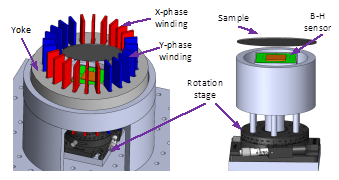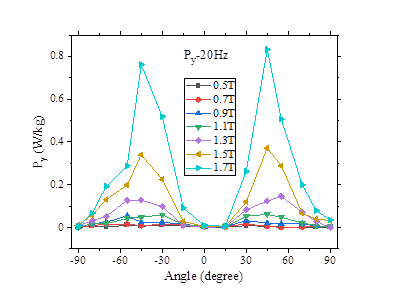Loss due to Transverse Field in Grain-oriented Steels Considering Anisotropy Based on Modified RSS by Shuaichao Yue
11 May 2021
Introduction
The transverse flux and associated losses have been proven to exist even when electrical steel is magnetized longitudinally. This blog presents a systematic analysis of loss properties of 0.23mm GO steel, considering both anisotropy and the transverse magnetic field based on a modified rotational single sheet tester (RSST).
Origin of transverse flux
The transverse flux and resulting loss are caused by the misaligned grains from the RD as shown in the following figure. Consider two Goss grains misaligned from the RD of a strip by an angle α. Suppose their domain structures in the presence of the external field Hex, applied along the RD, is as shown schematically in figure (a). The red and green arrows show the magnetisation directions in the four domains in each grain. The flux density out of each grain is B, so a demagnetising field Hd is set up in grain m as shown in figure (b). The resultant surface magnetic field strength H and B are not collinear and neither of them is directed along the RD. That is to say, both longitudinal and transverse components of magnetic field exist. This situation becomes more complex when applied field are along other directions.

Experimental setup
Main features:
- Flexible angle adjustment by rotation stage.
- Only one sample is required for anisotropic testing.
- Vector fields to be acquired with only one-phase excitation.
- Circular sample excludes the shape anisotropy.

Results and discussion
The following figure shows the variation of longitudinal loss (Px), transverse loss (Py) and proportion of transverse loss in terms of total loss (Pt) with magnetization angles regarding rolling direction. It can be seen that Px and Py have obviously different anisotropic behavior. The maximum of Px shifts from 90o to about 55o with increasing induction whilst the maximum of Py always occurs around 45o. This is caused by the complex domain evolution behavior and will be further investigated in future work.



Possible application
Methods for making computational field solvers take account of the strong effect of the anisotropy of GO steel, but take no account of the grain and domain structures, which have a controlling influence in determining the local flux and loss distribution in magnetic cores. However, they are usually made to work reasonably well by including correction factors based on previous practical performance data. Taking transverse flux and anisotropy into consideration may help developing improved loss predictors.
Conclusions
- The anisotropic loss behavior of GO steel, where the transverse loss is taken into account, is first being measured and presented systematically with a modified RSST.
- The transverse loss shows strong dependence on the direction, magnitude and frequency of the unidirectional excitations and should be included for accurate loss estimation. This proportion of transverse loss can be up to 40% with a 20Hz, 1.7T alternating excitation from 45o

